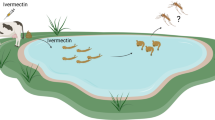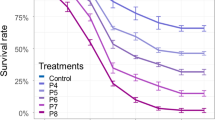Abstract
Coelomomyces indicus was reisolated from six larvae of Anopheles gambiae in Uganda. A crustacean copepod Cyclops sp. was found to be infected (63%). This indicated that the copepod could be an intermediate host for the fungus. All the four instars were highly susceptible to C. indicus but fourth instar Aedes aegypti was fairly susceptible (94.2%), while second instar An. gambiae (100%) and second instar C. fatigans (100%) were the most susceptible.
Laboratory tests were conducted to compare reproductive capacity and longevity of An. gambiae, C. fatigans and Ae. aegypti when infections of C. indicus were induced in each of the different larval instars. Infections of C. indicus sharply reduced the reproductive capacity and longevity of An. gambiae, C. fatigans and Ae. aegypti, regardless of the instar that were exposed and became infected. The reductions were highest when first and second instars were exposed. The tests indicated that introduction of C. indicus into laboratory populations of An. gambiae, C. fatigans and Ae. aegypti consisting of mixed larval instars, could significantly reduce the number and fertility of eggs and thus result in an average reduction of about 65.4% for An. gambiae, about 46.7% for C. fatigans and 58.7% for Ae. aegypti of the F1 progeny from those females that became infected. The importance of these results in biological control is discussed.
Résumé
Coelomomyces indicus a été réisolé à partir de 6 larves d’Anopheles gambiae en Uganda. On a trouvé qu’un copépode crustacéen Cyclops sp. était infecté (63%). Cela indiquait que le copépode pourrait être un hôte intermédiaire pour le champignon. Tous les stades morphologiques étaient très susceptibles au C. indicus, mais le quatrième stade Aedes aegypti était assez suceptible (94.2%), tandis que le 2 ème stade An. gambiae (100%) et le 2 ème stade C. fatigans (100%) étaient les plus susceptibles.
On a effectué des examens de laboratoire pour comparer la capacité reproductive et la longévité de An. gambiae, C. fatigans et Ae. aegypti lorsque les infections de C. indicus étaient induites dans chacun des différents stades larvaires. Les infections causées par C. indicus ont réduit d’une façon prononcée la capacité reproductive et la longévité de An. gambiae, C. fatigans et Ae. aegypti indépendemment du stade morphologique exposé et infecté. Les réductions les plus importantes étaient observées lorsque les 1 ère et 2 ème stades étaient exposés. Les examens ont indiqué que l’introduction de C. indicus dans les populations de An. gambiae, C. fatigans et de Ae. aegypti consistant de mélanges de larves à différents stades morphologiques pouvaient réduire de façon significative les effectifs et la fertilité des oeufs et ainsi donner lieu à une réduction d’environ 65,4% pour An. gambiae, environ 46,7% pour C. fatigans et 58,7% pour Ae aegypti des decendants F1 provenant des femelles qui étaient infectées. L’importance de ces résultats dans le contrôle biologique est discutée.
Similar content being viewed by others
References
Chapman H. C. (1974) Biological control of mosquito larvae. A. Rev. Ent. 19, 33–59.
Federici B. A. (1975) Cyclops vernalis (Copepods: Cyclopoida): An alternate host for the fungus Coeiomomyces punctatus. Proc. Calif. Mosq. Contr. Ass. 43, 172–174.
Federici B. A. (1980) Production of the mosquito-parasitic fungus, Coeiomomyces dodgei through synchronised infection and growth of the Intermediate copepod host, Cyclops vernalis. Entomophaga 25, 209–217.
Federici B. A. and Roberts D. W. (1976) Experiments with Coeiomomyces punctatus in An. quadrimaculatus. J. invertebr. Path. 27, 333–341.
Federici B. A. and Chapman H. C. (1977) Coeiomomyces dodgei: Establishment of an in-vivo laboratory culture. J. invertebr. Path. 30, 288–297.
Kellen W. R., Clark T. B. and Lindergren J. B. (1963) A host record of Coeiomomyces psorophorae Couch in California. J. invertebr. Path. 5, 167–173.
Laird M. (1967) A coral Island experiment: A new approach to mosquito control. WHO Chronicle 21, 18–26.
Laird M. and Colless D. H. (1959) Experiments towards the biological control of mosquitoes in the Tokelau Islands. First Report WHO ¡MHO/PA/93.59.
Laird M. and Colless D. H. (1962) A field experiment with a fungal pathogen of mosquitoes in the Tokelau Islands. Proceedings of the XI International Congress on Entomology, Vienna 2, 867–868.
Roberts D. W. (1974) Fungal infections of mosquitoes. In Le Controle des Mostiques¡Mosquito Control (Edited by Aubin, A., Bourasce J. P., Bellencik, S., Pellissier M. and Lacouraiere E.) Proceedings of the International Seminar on Mosquito Control May 1975. University of Quebec Press, Quebec.
Walker A. J. (1938) Fungal infection of mosquitoes especially of Anopheles costalia. Ann. trop. Med. Parasit. 32, 231–244.
Whisler H. C., Zebold S. B. and Shemanchuk J. A. (1974) Alternate host for mosquito parasite Coeiomomyces. Nature, Lond. 251, 715–716.
Whisler H. C., Zebold S. L. and Shemanchuk J. A. (1975) Life history of Coeiomomyces psorophorae. Proc. natn. Acad. Sci. U.S.A. 72, 693–696.
Author information
Authors and Affiliations
Rights and permissions
About this article
Cite this article
Nnakumusana, E.S. The Effect of Coelomomyces Indicus on the Fecundity and Longevity of Anopheles Gambiae, Culex Fatigans and Aedes Aegypti Exposed to Infection at Each Larval Instar. Int J Trop Insect Sci 7, 139–142 (1986). https://doi.org/10.1017/S1742758400008869
Received:
Revised:
Published:
Issue Date:
DOI: https://doi.org/10.1017/S1742758400008869
Key Words
- Anopheles gambiae
- Culex fatigans
- Aedes aegypti
- Coelomomyces indicus
- mosquito larvae
- biological control
- fecundity and longevity
- Cyclops sp. copepod




